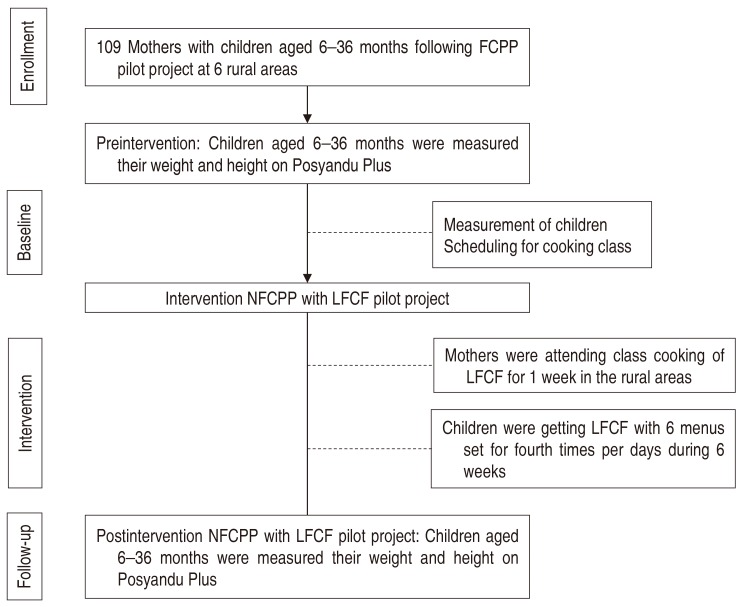1. Pasricha SR, Biggs BA. Undernutrition among children in South and South-East Asia. J Paediatr Child Health 2010;46:497–503.


2. Prado EL, Dewey KG. Nutrition and brain development in early life. Nutr Rev 2014;72:267–284.


3. Blaney S, Februhartanty J, Sukotjo S. Feeding practices among Indonesian children above six months of age: a literature review on their potential determinants (part 2). Asia Pac J Clin Nutr 2015;24:28–37.

4. Blaney S, Februhartanty J, Sukotjo S. Feeding practices among Indonesian children above six months of age: a literature review on their magnitude and quality (part 1). Asia Pac J Clin Nutr 2015;24:16–27.

5. Sandjaja S, Budiman B, Harahap H, Ernawati F, Soekatri M, Widodo Y, et al. Food consumption and nutritional and biochemical status of 0·5-12-year-old Indonesian children: the SEANUTS study. Br J Nutr 2013;110(Suppl 3): S11–S20.


6. Sudfeld CR, McCoy DC, Danaei G, Fink G, Ezzati M, Andrews KG, et al. Linear growth and child development in low- and middle-income countries: a meta-analysis. Pediatrics 2015;135:e1266–e1275.


7. Syahrul S, Kimura R, Tsuda A, Susanto T, Saito R, Ahmad F. Prevalence of underweight and overweight among school-aged children and it's association with children's sociodemographic and lifestyle in Indonesia. Int J Nurs Sci 2016;3:169–177.

8. Fahmida U, Santika O, Kolopaking R, Ferguson E. Complementary feeding recommendations based on locally available foods in Indonesia. Food Nutr Bull 2014;35(4 Suppl): S174–S179.


9. World Health Organization. Global strategy for infant and young child feeding. Geneva: World Health Organization, 2003.
10. Andriani H, Liao CY, Kuo HW. Association of Maternal and Child Health Center (Posyandu) Availability with Child Weight Status in Indonesia: A National Study. Int J Environ Res Public Health 2016;3 07 13(3): pii: E293

11. Nazri C, Yamazaki C, Kameo S, Herawati DM, Sekarwana N, Raksanagara A, et al. Factors influencing mother's participation in Posyandu for improving nutritional status of children under-five in Aceh Utara district, Aceh province, Indonesia. BMC Public Health 2016;16:69.


12. Budiman B, Sofiati F. Related knowledge and attitude about women children familyconscious nutrition (Kadarzi) with nutritional status of children in the village Gekbrong District Gekbrong 2015 In: Proceedings of International Seminar and Workshop on Public Health Action "Building Healthy Community."; 2015;pp 87–92.
13. Depkes RI. General guidelines for complementary feeding based on locally food. Jakarta: Departemen Kesehatan RI, 2006;:12–25.
14. World Health Organization. WHO child growth standards: methods and development. Geneva: World Health Organization, 2014.
16. Ministry of Health Indonesia. Riset Kesehatan Dasar. Ministry of Health Indonesia. National of Basic Health Research 2013. Jakarta: Ministry of Health Indonesia, 2013 (Basic Health Research 2013). Jakarta: Ministry of Health Indonesia, 2013;(Basic Health Research 2013).
17. Huriah T, Trisnantoro L, Haryanti F, Julia M. Upaya peningkatan status gizi balita malnutrisi akut berat melalui program home care. J Kesehat Masy Nas 2014;9:129–135.
19. Susanto T, Sulistyorini L. Family friendly for improvement of using exclusive breast with integration family center nursing model and transcultural nursing model at Jember district, East Java province. Indones Nurs J Educ Clin 2014;1:156–166.
20. Susanto T. Handbook of family health nursing: application of theory in family health nursing practices. Jakarta: Trans Info Media, 2012.
21. Susanto T, Raharto A. The differences of nutrient status of children aged 0-4 months between getting exclusive breastfeeding and complementary breastfeeding in Gentong village of Tegalampel, Bondowoso District. Spirulina 2008;3:1–6.
22. Susanto T, Rahmawati I. Relactation method for improving exclusive breast feeding at Arjasa community health center, sub-province Jember, East Java, Indonesia. Malays J Nurs 2015;6:24–32.
23. Susanto T, Dewi EI, Widayati N. The effect of peer groups discussion for knowledge, attitudes, and skills of mothers to improve of using exclusive breastfeeding in Jember districts. Ilmu Pengetah Sos 2008;10:1–12.
24. Syahrul Kimura R, Tsuda A, Susanto T, Saito R, Agrina A, et al. Parental perception of the children’s weight status in Indonesia. Nurs Midwifery Stud Forthcoming 2016.
25. Skinner AM, Cieslak Z, MacWilliam L, Solimano A, Kitson HF. The measurement of knee-heel length in newborn infants using a simple vernier calipers. Acta Paediatr 1997;86:512–517.


26. Susanto T, Sulistyorini L, Wuryaningsih EW, Bahtiar S. School health promotion: a cross-sectional study on clean and healthy living program behavior (CHLB) among Islamic Boarding Schools in Indonesia. Int J Nurs Sci 2016;3:291–298.





 PDF Links
PDF Links PubReader
PubReader ePub Link
ePub Link PubMed
PubMed Download Citation
Download Citation


